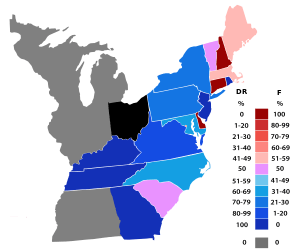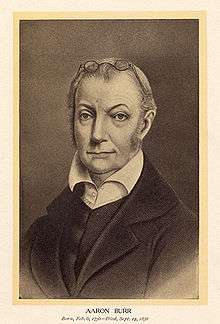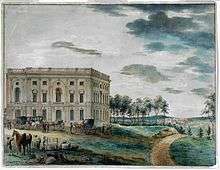7th United States Congress
| 7th United States Congress | |||||||||||||||||||||||||||||
| |||||||||||||||||||||||||||||
The Seventh United States Congress was a meeting of the legislative branch of the United States federal government, consisting of the United States Senate and the United States House of Representatives. It met in Washington, D.C. from March 4, 1801, to March 4, 1803, during the first two years of Thomas Jefferson's presidency. The apportionment of seats in the House of Representatives was based on the First Census of the United States in 1790. Both chambers had a Democratic-Republican majority, except during the Special session of the Senate, when there was a Federalist majority in the Senate.
Major events
- March 4, 1801: Presidential inauguration of Thomas Jefferson
- May 10, 1801: The pascha of Tripoli declared war on United States by having the flagpole on the consulate chopped down
- March 16, 1802: West Point established
- February 24, 1803: First time an Act of Congress was declared unconstitutional: U.S. Supreme Court case, Marbury v. Madison
Major legislation
- April 29, 1802: Judiciary Act of 1802, ch. 31, 2 Stat. 156
- April 30, 1802: Enabling Act of 1802, ch. 40, 2 Stat. 173
States admitted

- Ohio was admitted as a state, having previously been a portion of the Northwest Territory. The exact date is unclear and in dispute, but it is undisputed that it was during this Congress. The official date when Ohio became a state was not set until 1953, when the 83rd U.S. Congress passed legislation retrospectively designating the date of the first meeting of the Ohio state legislature, March 1, 1803, as that date. However, on April 30, 1802, the 7th U.S. Congress had passed an act "authorizing the inhabitants of Ohio to form a Constitution and state government, and admission of Ohio into the Union." (Sess. 1, ch. 40, 2 Stat. 173) On February 19, 1803, the same Congress passed an act "providing for the execution of the laws of the United States in the State of Ohio." (Sess. 2, ch. 7, 2 Stat. 201) The Biographical Directory of the United States Congress states that Ohio was admitted to the Union on November 29, 1802, and counts its seats as vacant from that date.
Party summary
The count below identifies party affiliations at the beginning of the first session of this Congress, and includes members from vacancies and newly admitted states, when they were first seated. Changes resulting from subsequent replacements are shown below in the "Changes in membership" section.
Senate
Although the Federalists had more Senators during the very brief March 1801 special session, by the time the first regular session met in December 1801, the Democratic-Republicans had gained majority control.
| Party (shading shows control) |
Total | Vacant | ||
|---|---|---|---|---|
| Democratic- Republican (DR) |
Federalist (F) | |||
| End of the previous congress | 11 | 21 | 32 | 0 |
| Begin | 15 | 17 | 32 | 0 |
| End | 18 | 14 | 2 | |
| Final voting share | 56.3% | 43.8% | ||
| Beginning of the next congress | 22 | 9 | 31 | 3 |
House of Representatives

| Party (shading shows control) |
Total | Vacant | ||
|---|---|---|---|---|
| Democratic- Republican (DR) |
Federalist (F) | |||
| End of the previous congress | 49 | 56 | 105 | 1 |
| Begin | 65 | 40 | 105 | 1 |
| End | 64 | 41 | 3 | |
| Final voting share | 61.0% | 39.0% | ||
| Beginning of the next congress | 113 | 26 | 139 | 3 |
Leadership
Senate

Aaron Burr

Abraham Baldwin
- President: Aaron Burr (DR)
- President pro tempore: Abraham Baldwin (DR), first elected December 7, 1801
- Stephen R. Bradley (DR), first elected December 14, 1802
House of Representatives
- Speaker: Nathaniel Macon, (DR), elected December 7, 1801
Members
This list is arranged by chamber, then by state. Senators are listed in order of seniority, and Representatives are listed by district.
Senate
Senators were elected by the state legislatures every two years, with one-third beginning new six-year terms with each Congress. Preceding the names in the list below are Senate class numbers, which indicate the cycle of their election. In this Congress, Class 1 meant their term ended with this Congress, requiring reelection in 1802; Class 2 meant their term began in the last Congress, requiring reelection in 1804; and Class 3 meant their term began in this Congress, requiring reelection in 1806.
Connecticut
Delaware
Georgia
Kentucky
Maryland
Massachusetts
New Hampshire
New Jersey
New York
|
North Carolina
OhioRegardless of the uncertainty over Ohio's exact admittance date (see "States admitted, above") its two Senators were not elected until the next Congress.
Pennsylvania
Rhode Island
South Carolina
Tennessee
Vermont
Virginia
|
House of Representatives
The names of members of the House of Representatives elected statewide on the general ticket or otherwise at-large, are preceded by an "At-large," and the names of those elected from districts, whether plural or single member, are preceded by their district numbers.
Changes in membership
The count below reflects changes from the beginning of the first session of this Congress.
Senate
There was 1 death, 8 resignations, and 2 seats added for a new state.
| State (class) |
Vacator | Reason for change | Successor | Date of successor's formal installation |
|---|---|---|---|---|
| Rhode Island (2) |
Ray Greene (F) | Resigned March 5, 1801, after being nominated for a judicial position. His successor was elected. | Christopher Ellery (DR) | Seated May 6, 1801 |
| South Carolina (2) |
Charles Pinckney (DR) | Resigned June 6, 1801, after being appointed Minister to Spain. His successor was elected. | Thomas Sumter (DR) | Seated December 15, 1801 |
| New Hampshire (2) |
Samuel Livermore (F) | Resigned June 12, 1801. His successor was elected. | Simeon Olcott (F) | Seated June 17, 1801 |
| Pennsylvania (3) |
Peter Muhlenberg (DR) | Resigned June 30, 1801. His successor was appointed July 13, 1801 and then elected December 17, 1801. | George Logan (DR) | Seated July 13, 1801 |
| Vermont (3) |
Elijah Paine (F) | Resigned September 1, 1801. His successor was elected. | Stephen R. Bradley (DR) | Seated October 15, 1801 |
| Maryland (3) |
William Hindman (F) | Resigned November 19, 1801. His successor was elected. | Robert Wright (DR) | Seated November 19, 1801 |
| New York (3) |
John Armstrong Jr. (DR) | Resigned February 5, 1802. His successor was elected. | DeWitt Clinton (DR) | Seated February 9, 1802 |
| New Hampshire (3) |
James Sheafe (F) | Resigned June 14, 1802. His successor was elected. | William Plumer (F) | Seated June 17, 1802 |
| South Carolina (3) |
John E. Colhoun (DR) | Died October 26, 1802. His successor was elected. | Pierce Butler (DR) | Seated November 4, 1802 |
| Ohio (1) |
New seats | Ohio was admitted to the Union on November 29, 1802. | Vacant | Not filled this Congress |
| Ohio (3) |
Vacant |
House of Representatives
- replacements: 8
- Democratic-Republicans: no net change
- Federalists: no net change
- deaths: 1
- resignations: 9
- forfeiture: 1
- vacancy: 1
- Total seats with changes: 11
| District | Vacator | Reason for change | Successor | Date successor seated |
|---|---|---|---|---|
| Connecticut At-large |
Vacant | Elizur Goodrich (F) resigned before the beginning of this Congress. | Calvin Goddard (F) | December 7, 1801 |
| Massachusetts 4th |
Levi Lincoln (DR) | Resigned March 5, 1801, after being appointed US Attorney General. | Seth Hastings (F) | January 11, 1802 |
| New York 6th |
John Bird (F) | Resigned July 25, 1801. | John Peter Van Ness (DR) | December 7, 1801 |
| New York 5th |
Thomas Tillotson (DR) | Resigned August 10, 1801, upon appointment as NY Secretary of State. | Theodorus Bailey (DR) | December 7, 1801 |
| Massachusetts 12th |
Silas Lee (F) | Resigned August 20, 1801. | Samuel Thatcher (F) | December 6, 1802 |
| South Carolina 4th |
Thomas Sumter (DR) | Resigned December 15, 1801, after being elected to the US Senate. | Richard Winn (DR) | January 24, 1803 |
| Georgia At-large |
Benjamin Taliaferro (DR) | Resigned sometime in 1802. | David Meriwether (DR) | December 6, 1802 |
| New Hampshire At-large |
Joseph Peirce (F) | Resigned sometime in 1802. | Samuel Hunt (F) | December 6, 1802 |
| Maryland 2nd |
Richard Sprigg, Jr. (DR) | Resigned February 11, 1802. | Walter Bowie (DR) | March 24, 1802 |
| Mississippi Territory At-large |
Narsworthy Hunter | Died March 11, 1802. | Thomas M. Green, Jr. | December 6, 1802 |
| Georgia At-large |
John Milledge (DR) | Resigned May 1802 after being elected Governor. | Peter Early (DR) | January 10, 1803 |
| North Carolina 8th |
Charles Johnson (DR) | Died July 23, 1802. | Thomas Wynns (DR) | December 7, 1802 |
| Ohio At-large |
New seat | Ohio was admitted to the Union on November 29, 1802. | Vacant | Not filled until next Congress |
| New York 6th |
John Peter Van Ness (DR) | Seat declared forfeited January 17, 1803. | Vacant |
Committees
Lists of committees and their party leaders.
Senate
House of Representatives
- Claims
- Commerce and Manufactures
- Elections
- Revisal and Unfinished Business
- Rules (Select)
- Standards of Official Conduct
- Ways and Means
- Whole
Joint committees
Officers
Senate
- Chaplain: Thomas J. Claggett (Episcopalian)
- Edward Gantt (Episcopalian), elected December 9, 1801
- Secretary: Samuel A. Otis
- Doorkeeper: James Mathers
House of Representatives
- Chaplain: William Parkinson (Baptist)
- Clerk: John Beckley
- Doorkeeper: Thomas Claxton
- Sergeant at Arms: Joseph Wheaton
See also
- United States elections, 1800 (elections leading to this Congress)
- United States elections, 1802 (elections during this Congress, leading to the next Congress)
References
- ↑ The official date when Ohio became a state was not set until 1953, when the 83rd U.S. Congress passed legislation retrospectively designating the date of the first meeting of the Ohio state legislature, March 1, 1803, as that date. However, on April 30, 1802, the 7th U.S. Congress had passed an act "authorizing the inhabitants of Ohio to form a Constitution and state government, and admission of Ohio into the Union." (Sess. 1, ch. 40, 2 Stat. 173) On February 19, 1803, the same Congress passed an act "providing for the execution of the laws of the United States in the State of Ohio." (Sess. 2, ch. 7, 2 Stat. 201) The Biographical Directory of the United States Congress states that Ohio was admitted to the Union on November 29, 1802, and counts its seats as vacant from that date.
- 1 2 Pennsylvania's 4th district was a plural district with two representatives.
- Martis, Kenneth C. (1989). The Historical Atlas of Political Parties in the United States Congress. New York: Macmillan Publishing Company.
- Martis, Kenneth C. (1982). The Historical Atlas of United States Congressional Districts. New York: Macmillan Publishing Company.
External links
- Statutes at Large, 1789-1875
- Senate Journal, First Forty-three Sessions of Congress
- House Journal, First Forty-three Sessions of Congress
- Biographical Directory of the U.S. Congress
- U.S. House of Representatives: House History
- U.S. Senate: Statistics and Lists
